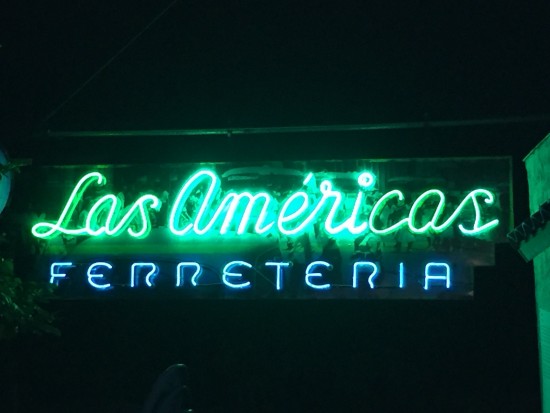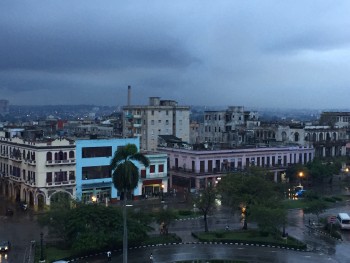
Day 3
I thought it would get light out earlier but at 6:30 it is still very dark. One of the things you notice here is the lack of lighting..many of the roads – and main ones at that – do not have street lamps or, at least, only very sparingly. And there is little light coming from the buildings. Gives one a sense of emptiness – in fact, there is an overwhelming sense that the buildings are uninhabited and yet, when you get in to the crumbling streets of the old town with bicycle rickshaws and classic car taxis weaving through scantily clad pedestrians, you feel the press of people. I am told that Cuba was the second stop for Mr. Columbus – 1492 he arrived here from DR and stopped on the eastern tip of the island. He continued on to the southern coast and then went back to Spain, convinced he had reached the mainland. It was the mariner, Ocampo, who sailed on along the south coast and then turned north and back around through the waters that are a mix of the Caribbean and Atlantic, past what is now the Malecon and into the channel that leads to Havana’s protected port. He stopped at the point where Old Havana begins and put down roots. Where Columbus thought he had reached the mainland when bumping in to Cuba, Ocampo determined that Cuba was, in fact, an island. You can see all of this, as we did, from the fort across the channel, a wonderful mirador that gives you your bearings and context. I always take guests to the highest point, if I can, when designing a trip because you must know not only where you are but why you – and the people you are visiting — are there. I was thrilled yesterday when the young man I told you about at the Ludwig Foundation, Alvaro, spoke to me about the significance of the geographical position of the island. I had asked him why he thought Cuba was such a rich seam of artistic talent and he mentioned two things I would not have thought of: that, because of its geographical position, the island became the hub for Spanish exploration of the Caribbean; the galleons would come here first, offload goods, reprovision, and then move along the gulf stream up to the US or down to other islands, thus bringing a tide of people, ideas, and materials to Cuba first. This washing of shores with newness is an important point, and we have seen it in Indonesia and on the coast of Africa, have we not? And the second point was equally important: the education of the arts. In the schools here the arts are taught with the same intensity as are the sciences and if a child evinces any predisposition, interest or talent for any kind of art – plastic, graphic, dance, theatre, film, music, design – they are given classes all the way through to university by professionals in their field. (This, actually, is changing now and the arts are only taught, I am told, for four years and not throughout the school life of the student.) So, the point being, that it is not enough to have the passion and the spark of talent, it must be disciplined and shaped. Thus you have an extraordinary flowering of talent amongst the people. I would add a 3rd point and that is that in a culture that educates equally the sciences and the arts, it changes the mentality of a people and, particularly, of the child. In our country how many times have you heard an actor or musician say that his/her parents wanted him/her to pursue a profession that made money rather than one that was financially iffy? Here, in a culture that has been (heretofore – not anymore and more on that later) literally equal in the marxist sense..where a heart surgeon made as much as a musician, there was no incentive to pursue one field over another for monetary reasons. Which leads to the question of what now? I am told there are about 2000 millionaires on the island, 80-90% here in Havana. Many of these are artists, by the way; the rest in various entrepreneurial pursuits or in real estate. That is in a population of 11.5 million. This is new and is going to turn the country topsy turvy I would imagine. And what is interesting is that, when I asked our guide, David (the one who has been a diplomat and criminal lawyer and is now the tour guide because he makes more money this way), if these millionaires were interested in reinvesting in their country, he told me NO, that they cannot because then the government would know that they were making money and were wealthier than their compatriots which, from an ideological viewpoint, is still not accepted even though, in reality, the times have changed
Cuba astounds me.
I could get lost here, in this place that is so close and yet so far.
I could lose myself in its story-rich pentimento and in its exuberant, creative potential.
This is a moment, in a place, where the past and the future touch each other.
Easily, and with great sweetness, I am drawn by the kinship that is our history,
and I long for more.
Havana, Cub. Photo: Lisa Lindblad
" ["post_title"]=> string(15) "Meditations #70" ["post_excerpt"]=> string(0) "" ["post_status"]=> string(7) "publish" ["comment_status"]=> string(4) "open" ["ping_status"]=> string(4) "open" ["post_password"]=> string(0) "" ["post_name"]=> string(14) "meditations-70" ["to_ping"]=> string(0) "" ["pinged"]=> string(0) "" ["post_modified"]=> string(19) "2016-11-29 11:56:19" ["post_modified_gmt"]=> string(19) "2016-11-29 16:56:19" ["post_content_filtered"]=> string(0) "" ["post_parent"]=> int(0) ["guid"]=> string(31) "http://lisalindblad.com/?p=5158" ["menu_order"]=> int(0) ["post_type"]=> string(4) "post" ["post_mime_type"]=> string(0) "" ["comment_count"]=> string(1) "0" ["filter"]=> string(3) "raw" } }